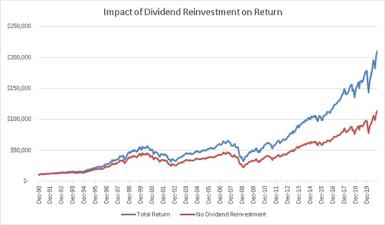Why and How to Invest in Dividend-Paying Stocks

Dividend-paying stocks are an essential part of many investors’ portfolios—though not always for the same reasons.
Those with a long-time horizon, for example, often reinvest their dividends as a means of boosting returns. In fact, $10,000 in a hypothetical investment that tracked the S&P 500® Index fund in 1991 would have swelled to more than $211,000 by the end of 2020 had dividends been reinvested, but only to $114,000 had dividends not been reinvested (see “The dividend dividend,” below).
The dividend dividend
Over 30 years, a portfolio that reinvested its dividends far outpaced one that did not.
Source: Morningstar Direct. Data from 01/01/1990 through 12/31/2020. Portfolio 1 assumes an initial investment of $10,000 and that all dividends were reinvested. Portfolio 2 assumes an initial investment of $10,000 and that no dividends were reinvested. Returns are represented by the Ibbotson® SBBI® US Large-Cap Stocks (Total Return) and the Ibbotson® SBBI® US Large-Cap Stocks (Capital Appreciation Return), respectively. This chart shows a hypothetical investment and is for illustrative purposes only. It does not reflect the effects of taxes, expenses or fees. Past performance is no guarantee of future results.
For retirees, on the other hand, the regular payouts from dividend-producing stocks have the potential to provide a steady stream of income. And whereas dividend yields from companies in the S&P 500 may have declined over time, it’s important to consider them in the context of inflation.
When inflation is high, it erodes your purchasing power, meaning your dividends must be greater to keep pace with rising prices. The opposite is also true: A low-inflation environment, like the current one, puts less pressure on income. Consequently, you want your dividends to regularly exceed, or at least keep pace with, the rate of inflation—something companies in the S&P 500 has been doing for the better part of five years (see “Preserving purchasing power,” below).
Preserving purchasing power
Dividends from companies in the S&P 500 may have declined, but they have surpassed inflation since 2012.
Source: Robert Shiller and the U.S. Bureau of Labor Statistics. Data are from 01/01/1979 through 12/31/2020. Past performance is no guarantee of future results.
Not all companies pay dividends, of course. Smaller and less-established companies, which may often provide shareholders with above-average returns, can justify reinvesting in themselves rather than paying out dividends.
Larger and more-established companies, by comparison, tend to see slower growth and lower stock returns, and so will typically pay dividends to help retain existing shareholders and attract new ones. Indeed, of the 500 large-cap stocks tracked by the S&P 500, more than four-fifths pay dividends.1
Finding dividend payers
When it comes to investing in dividend stocks, many investors turn to mutual funds or exchange-traded funds that offer access to dividend-paying companies across industries.
Those who prefer to hold individual stocks might instead want to follow in the footsteps of famed investor Benjamin Graham, who favored companies with three attributes:
- A history of steady dividend growth: Consistently increasing dividends is generally an indicator of healthy corporate fiscal policy.
- A low payout ratio: When companies exhibit a low ratio of dividends to earnings, it suggests they’re retaining some earnings, making it less likely they’ll reduce dividends in the future.
- A respectable current dividend rate: According to research by Robert D. Arnott and Clifford S. Asness, low dividends beget lower stock prices, while high dividends beget higher stock prices.2 However, unusually high dividends can be a sign of corporate distress, so a good rule of thumb is to look for those yielding at least as much as the current 10-year Treasury but no more than twice that amount.
Not only may these key characteristics help you identify worthy dividend payers, but companies exhibiting such attributes also tend to be higher quality with lower leverage and debt—which could help your portfolio better weather a downturn.
A word of caution
That said, no investment vehicle is perfect. Dividend stocks are subject to the same vicissitudes as all other equities. And unlike bonds—whose coupon payments are nearly guaranteed, barring default—their payouts could be trimmed or eliminated altogether without warning.
All of which is to say that dividend stocks should not be viewed as a replacement for traditional fixed income investments but rather as a complement to a diversified portfolio.
1Bloomberg®, as of 3/9/2021.
2“Surprise! Higher Dividends = Higher Earnings Growth ,” Financial Analysts Journal, 2003.
What you can do next
Schwab clients: Log in and screen for dividend-paying stocks.
Need help with your investments? Call 800-355-2162 or visit your local branch.
 By
By

